
The story of jeans begins long before they became the comfortable uniform for farmers and gold miners, and it ends with a condemnation of violence. The annual Denim Day is a calendar event that has little to do with the jeans themselves.
A Timely Idea
The inventor of the world’s most popular clothing item is not a tailor, but a merchant: Levi Strauss, the founder of Levi Strauss & Co, never sewed a stitch himself. In 1847, 18-year-old Löb (Leiba) Strauss emigrated from Bavaria, Germany, to the “land of opportunity.” In the U.S., he adopted the name Levi, which Americans pronounced as “Levi,” and slightly altered his surname to Strauss. In his new home, Levi Strauss made a living selling dry goods and tools in Kentucky, where he learned the trade through hands-on experience as a traveling salesman.
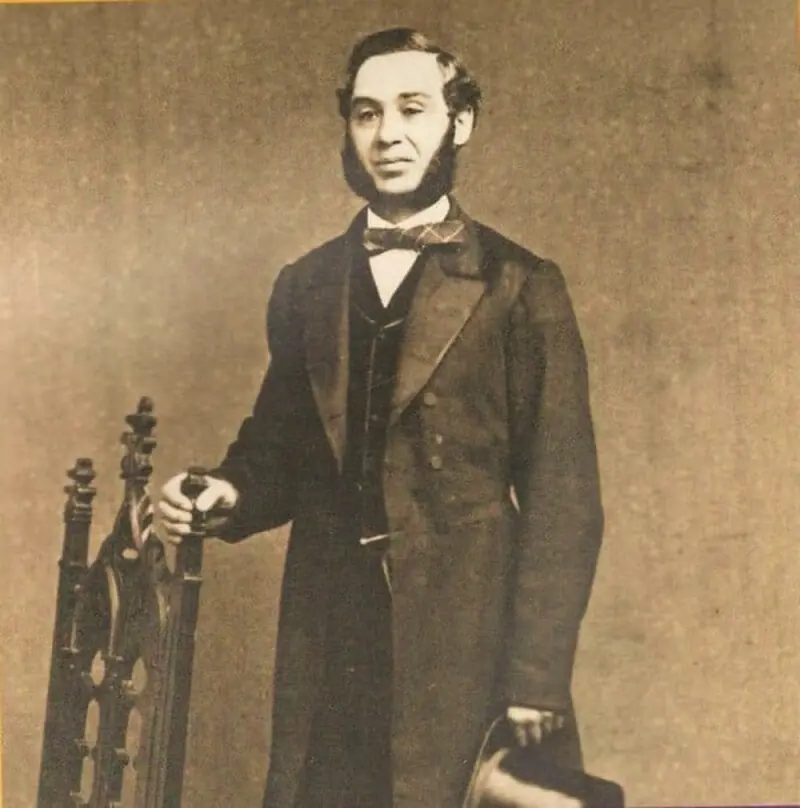 After his father’s death, the future business mogul joined his mother and sisters to reunite with his older brothers, who had crossed the ocean two years earlier to trade in fabrics. One day, Levi Strauss brought their goods to San Francisco, which had become the epicenter of the Gold Rush since 1849. Selling his wares almost straight off the ship, he commissioned a tailor to make pants from leftover sailcloth, which were soon appreciated for their comfort by gold seekers. From that moment on, the American entrepreneur dedicated his life to creating the world’s most popular pants, while the contributions of his predecessors to this significant invention faded into obscurity.
After his father’s death, the future business mogul joined his mother and sisters to reunite with his older brothers, who had crossed the ocean two years earlier to trade in fabrics. One day, Levi Strauss brought their goods to San Francisco, which had become the epicenter of the Gold Rush since 1849. Selling his wares almost straight off the ship, he commissioned a tailor to make pants from leftover sailcloth, which were soon appreciated for their comfort by gold seekers. From that moment on, the American entrepreneur dedicated his life to creating the world’s most popular pants, while the contributions of his predecessors to this significant invention faded into obscurity.
Author’s Patent
Levi Strauss founded his namesake denim empire in 1853. The first jeans from Levi Strauss & Co were sold for $1.50. The initial price for workwear for miners and cowboys was $1.46. The birth date of this iconic new generation of clothing is considered to be May 20, 1873, when the patent for pants made from hemp sailcloth with copper rivets was officially registered. Patent No. 139121 was issued for the construction of work pants without suspenders, featuring four pockets—three large ones for small items and tools, and a small pocket for coins. The characteristic five-pocket design that would follow began with the 501 model, which had two pockets in the front, two in the back, and a “watch pocket” on the right side in front.
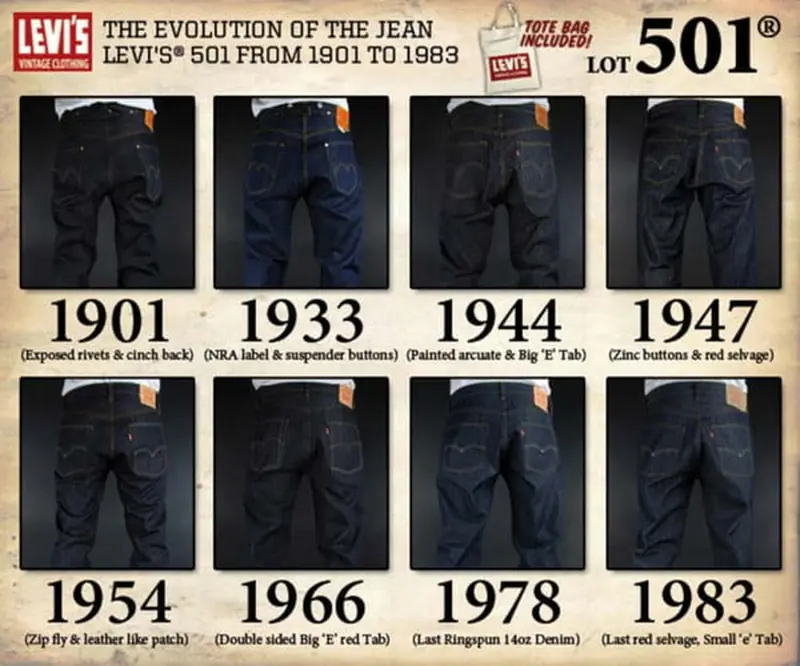
Initially, the denim fabric was not cotton but hemp: thanks to the sailcloth of English and American origin, the new pants gained a reputation for being incredibly durable. This durability has been advertised for over a century and a half by the well-known leather label on original products. The image of two horses unsuccessfully trying to tear the pants in half appeared on Levi Strauss & Co jeans in 1886. The practical difference between work pants and traditional leather cowboy attire was that the new clothing for miners, farmers, shepherds, and laborers could be washed. The most color-safe dye was chosen for washing: at that time, natural indigo or indole (blue) was the most reliable dye for fabrics, which became the classic color of Levi’s jeans.
A Profitable Deal
An interesting fact in the history of jeans is a crucial detail: Levi Strauss obtained the patent for the production of pants in partnership with the inventor of metal rivets for pockets. Another Jewish immigrant played a role in the creation of this legendary clothing: the Bavarian was joined in the brand registration by Russian émigré Jacob Davis. Jacob Davis (as he became known in America) was the one who came up with the idea of reinforcing pocket seams with metal rivets. In his tailoring shop in Reno, he worked with the fabrics and dry goods from the Strauss brothers. He also sewed jeans on Levi Strauss’s orders. The creative tailor had the innovative idea to use rivets for an unusual purpose: no one had previously reinforced clothing parts with metal.

Jacob Davis immediately recognized the value of his business proposal to his future partner. The foundation of their long-term collaboration was a letter from the tailor in 1872: “The demand for these pants exceeds what one person can produce. This interest has largely arisen due to the rivets on the pockets. Therefore, I intend to register my idea with a patent to protect my priority. If you file the patent in my name, your expenses will be minimal compared to the potential profits from improving workwear—only $68 for an idea that you can apply to the production of pants, shirts, vests, jackets, and coats. My sewing experience indicates successful sales of such products, so the costs will quickly pay off.”
Metal and Sails
Ultimately, their joint patent application was approved. In the first year, the company managed to sell 21,000 pairs of pants and jackets with the signature copper rivets, which are still synonymous with Levi’s products in the 21st century. Initially, metal was even used on the zipper of the jeans, but after consumer complaints, manufacturers had to remove the “excess” that injured cowboys, damaged saddles while riding, and scratched chairs. The issue with metal in the “intimate area” posed a health risk for cowboys: when the “lords of the prairie” warmed themselves by the fire, the rivets made of heat-conductive material quickly heated up and burned the skin in “sensitive areas.”
Over time, Strauss’s company also moved away from using sailcloth. Levi only used the ship fabric for the first few years when it became very cheap due to a crisis in the shipbuilding industry. Eventually, hemp was replaced by cotton, and the “textile anachronism” was replaced by a softer fabric known as denim. The name of this material indicates its French origin: de Nimes translates to “from Nîmes,” a city in the south of France. From the English names denim and jeans, fashion historians have reconstructed the “true lineage” of jeans.
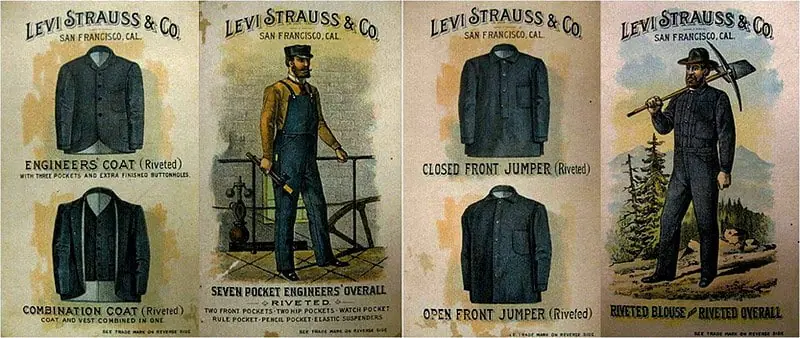
Harbingers of the Future
Everything new is well-forgotten old. If we set aside commercial priorities, calling Levi Strauss the inventor of jeans somewhat overlooks history. Essentially, in his invention, the founder of the denim empire merely improved upon certain clothing from the past. Ancient artists depicted sailcloth pants on sailors in the Italian port of Genoa as early as 1597. It is known that the woven fabric serge de Nimes (twill) was produced by French textile workers since the early 1300s. Sails made from this material were carried across the oceans by ships of Christopher Columbus’s expedition in 1492.
From the 16th century, European manufacturers used cotton twill with diagonal weaves to make men’s and women’s clothing. This assortment included pants, which were named after the material: in French, they were called jane, in English, jean, and in Italian, gene. The name of the Genoese fabric became a toponym for Genoa—the city that supplied the indigo dye used for jeans, which has been produced since ancient times: the fabric from an archaeological find in Peru is dated to be 6,200 years old. The difference between modern indigo-colored denim lies in the dyeing method. The hallmark of this technique is that before spinning, manufacturers dye only the longitudinal thread, weaving the transverse thread without dyeing. As a result, the reverse side appears lighter than the front, giving the fabric a distinctive look.
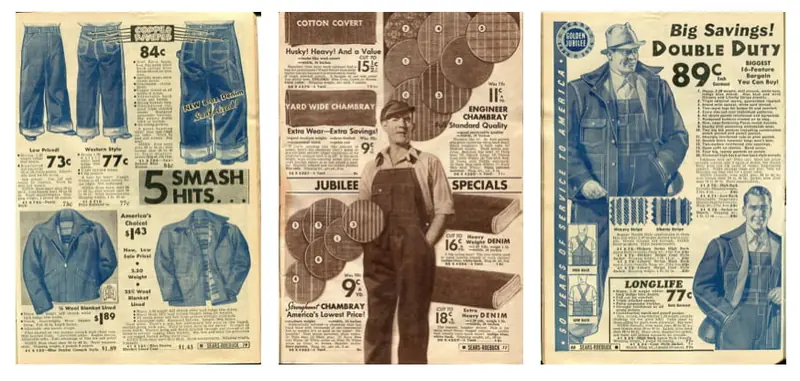
Fibers and Cuts
Modern types of denim include not only classic denim and its variant chambray: the most expensive, coarse materials that soften after washing. A cheaper variant of denim is jean—a fabric with uniform coloring of diagonal threads. Another possible type of denim is ecru: the unbleached cotton base of natural denim is named after the French word écru (translated as “unbleached” or “raw”). Denim is also made from chevron fabric (other names include broken twill or reverse twill), where the interweaving of threads creates a two-sided weaving pattern resembling a uniform broken line. Stretch denim fabrics are known as stretch (cotton blended with synthetic fibers like Lycra or elastane) and natural stretch (a material made from equal parts cotton and Chinese nettle).

Modern industry has also expanded the classic shape of jeans with various models. There are three main types of leg cuts: Straight Leg (straight along the entire length), Tapered Leg (narrowing towards the bottom), and Slim Leg (hugging the ankle). The construction of the fly (from the Dutch word gulp meaning “flap”) has also been named. Jeans with a button-fly closure in the front are called Button Fly, while pants with a zipper closure are known as Zip Fly. Structuring products by cut type became necessary to help customers navigate the wide selection of comfortable pants offered by designers.
Favorite Clothing
Classic five-pocket jeans of standard cut fall under the Regular Fit category (straight leg or slightly tapered at the bottom). Skinny jeans are tight-fitting. Slim jeans feature a tapered leg and a higher waistline. The opposite of Slim Fit is Relaxed Fit—a type of loose-fitting jeans. Loose Fit refers to the currently fashionable wide-leg jeans that are loose throughout (both at the top and bottom). Straight Fit jeans have a straight cut with the same width throughout (they can be very narrow or more relaxed). Baggy jeans, favored by rappers, are intentionally wide and saggy, even at the waist. Low Waist jeans have a dropped waistline. Easy Fit models also have a lowered waistline, with a slightly tapered leg at the ankle. Boot Cut jeans are elongated, hugging the hips, with a dropped waist and a leg that slightly flares from the knee to the ankle, covering shoes by the width of two fingers. Jeggings are pants that represent a designer “hybrid” of jeans and leggings. Despite this variety, the Basic cut, introduced by Levi Strauss, remains the foundational style: Basic jeans are the classic Western model with five pockets and a slightly tapered leg for easy tucking into boots.
 The industrial manufacturer of the first jeans combined the most rational technologies into one product, and the successors of the family business worked hard to spread practical workwear worldwide, making it a beloved wardrobe staple on all continents. Throughout its long history, the most famous brand in jeans has never left the ownership of the Strauss family: after the founder’s death in 1902, his profitable company was inherited by his nephews. Today, the descendants of the founder continue to own and manage the unrivaled denim empire of Levi Strauss & Co, and Levi’s jeans have carved out their own niche in fashion for all time.
The industrial manufacturer of the first jeans combined the most rational technologies into one product, and the successors of the family business worked hard to spread practical workwear worldwide, making it a beloved wardrobe staple on all continents. Throughout its long history, the most famous brand in jeans has never left the ownership of the Strauss family: after the founder’s death in 1902, his profitable company was inherited by his nephews. Today, the descendants of the founder continue to own and manage the unrivaled denim empire of Levi Strauss & Co, and Levi’s jeans have carved out their own niche in fashion for all time.
Denim Day
As for the calendar Denim Day (which falls on April 24, 2024), this date has no direct connection to the history of jeans. Wearing jeans on this day in several countries symbolizes a protest against sexual violence and its unjust assessment. Denim Day was first observed in the U.S. in 1999 in solidarity with a women’s protest in the Italian Parliament. American support was sparked by outrage over a controversial ruling by the Italian Supreme Court in a 1992 rape case. Italian judges shifted the blame for the rape from the perpetrator to the victim, citing her potential guilt… due to the tight jeans worn by the victim. Whether this provocative element of clothing, according to the judges’ verdict, incited the violence, or whether such clothing, in their opinion, required the woman’s personal involvement in her disrobing, the judges’ motives are not discussed but often shock society.
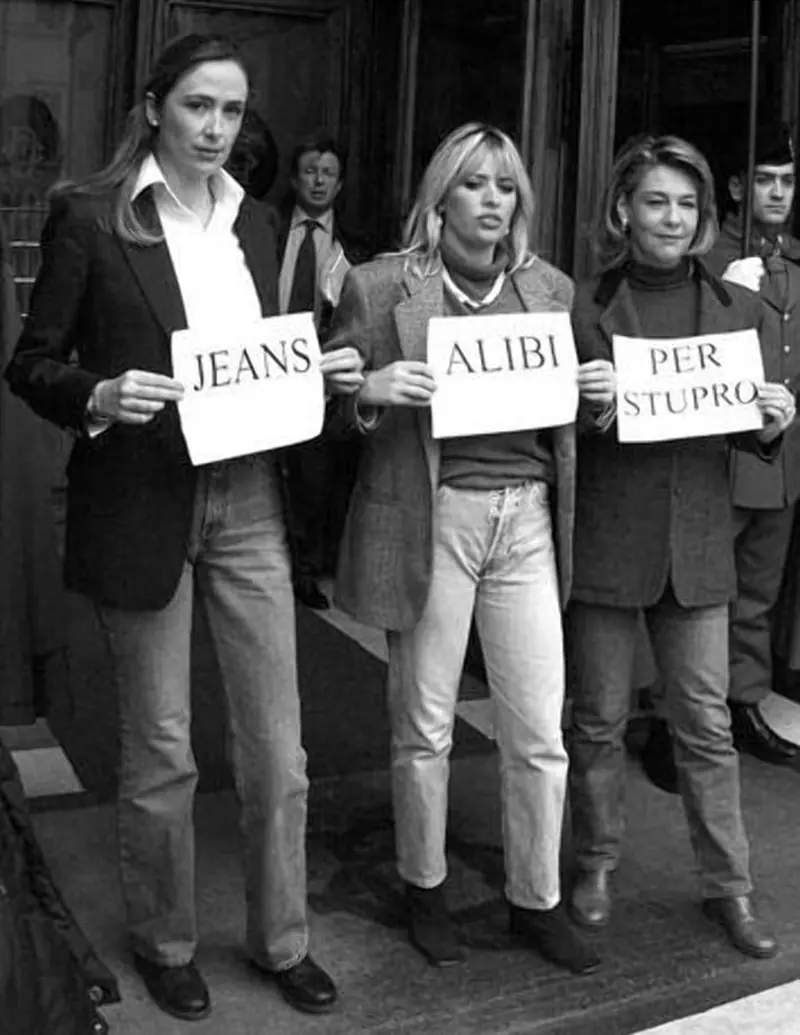
After the scandalous acquittal of the perpetrator, outraged Italian women went to the parliamentary chamber dressed in jeans, unfurling a banner that read, “Jeans—an alibi for the rapist?” They received support from the U.S. Senate: thanks to the efforts of the chairwoman of the committee investigating attacks on women, Denim Day became an annual event, initially in California and later in other American states, where millions of people wear jeans for ideological reasons on the last Wednesday of April.
